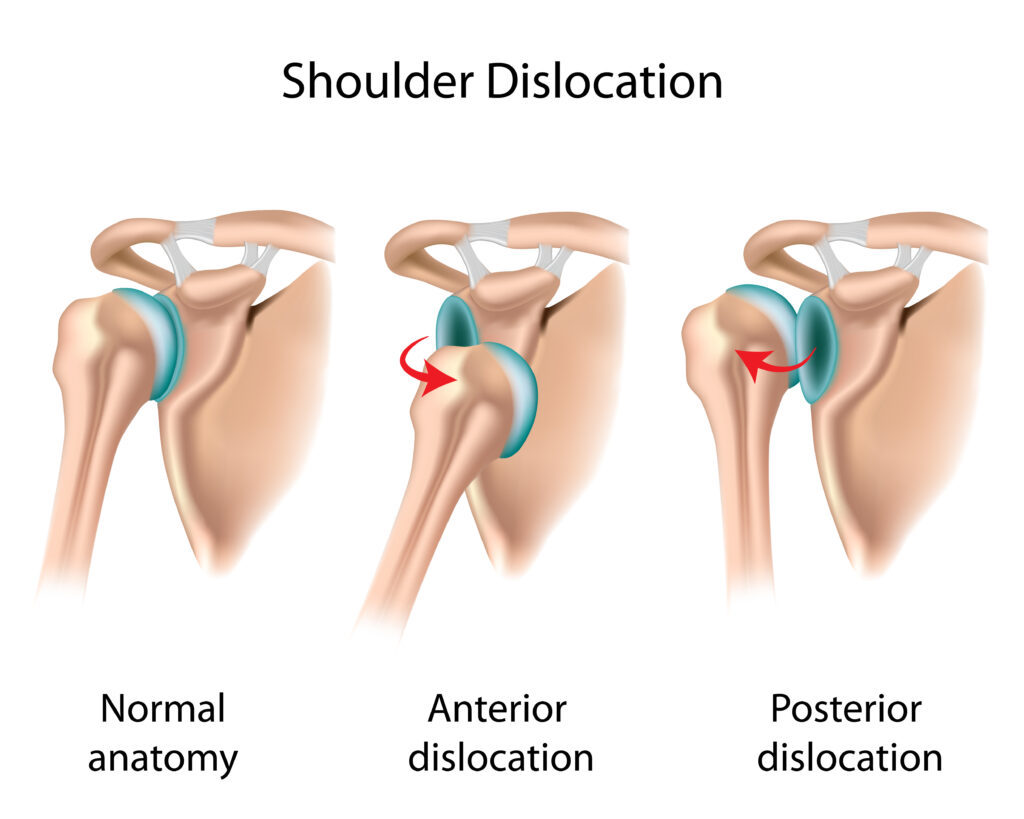Shoulder Dislocations
Shoulder Dislocations
The shoulder joint boasts unparalleled mobility and an extensive range of motion, allowing it to move in multiple directions. This flexibility is particularly advantageous when performing complex tasks. However, this degree of mobility comes at a cost. The shoulder joint is relatively susceptible to dislocation, a common condition treated by orthopedic practitioners. Dislocated shoulders are frequently observed in athletes, but they can also result from falls or other traumatic injuries. Dislocations can be classified as either partial or complete. In the case of partial dislocation, also referred to as a subluxation, the humerus moves partially out of the shoulder socket. In contrast, a complete dislocation occurs when the humerus completely exits the shoulder socket. Both forms of dislocation can cause shoulder pain and instability and require prompt medical intervention.
Injury Symptoms
Shoulder dislocations are typically accompanied by intense pain and a noticeable popping sound or sensation. Numbness and swelling usually follow. In addition, patients frequently describe a frozen or blocked feeling in the affected shoulder, signifying a loss of mobility until the joint is reset. The shoulder joint can dislocate backward, downwards, or forwards, the latter being the most common, also known as anterior instability. In severe cases, dislocations can damage tendons and ligaments. Without appropriate treatment, recurrent dislocations may occur, resulting from the instability created by the damaged tendons and ligaments.
Types of Shoulder Dislocations
Shoulder dislocations typically occur in one of two ways. The most prevalent types of dislocations are anterior dislocations and posterior dislocations.

Anterior Shoulder Dislocation
An anterior shoulder dislocation is the most common, accounting for 95% of all shoulder dislocations. In this type of dislocation, the humeral head of the shoulder is displaced inwardly. When a patient experiences an anterior shoulder dislocation, the shoulder often appears squared off, as the dislocation causes the shoulder to appear flat. This type of dislocation can occur with or without bone loss to the joint.
Posterior Shoulder Dislocation
Posterior shoulder dislocations are a rare type of dislocation, accounting for less than 5% of cases. They are typically the result of high-impact injuries where the arm is outstretched and internally rotated. Due to their rarity, posterior dislocations can be difficult to diagnose correctly. This injury occurs when the head of the humerus is pushed out of the glenoid cavity and moves posteriorly. Posterior dislocations can also result from neck trauma or a fracture of the neck or humerus. If not correctly identified, the injury can result in additional damage to ligaments, cartilage, or the rotator cuff.
Treatment Options
The treatment for shoulder dislocation is usually straightforward, involving placing the ball of the upper arm bone back into the joint socket. This process is called a closed reduction and can provide immediate pain relief. However, some rehab may be needed to ensure the shoulder is stable and to prevent further injury. In cases of more severe dislocations with ligament and tendon damage, repair of the shoulder joint may be necessary. Shoulder instability is a common cause of surgical repair. Arthroscopic surgery may be an option to remove any loose or damaged cartilage and repair damaged tendons, allowing the shoulder to regain stability. In addition, open surgical stabilization may be needed if the dislocation includes bone loss in the glenoid socket. This type of surgery is often necessary for repeated or recurrent dislocations without previous surgery or if a patient has previously had surgery to repair a torn ligament but still requires further stabilization. The Latarjet procedure is a commonly used surgical technique for repairing bone loss, involving transferring a small piece of bone from the shoulder blade socket to correct the bone loss.
Consult a Boise Orthopedic Surgeon Specializing in Shoulder Injuries
To ensure that future instability is eliminated, some cases of shoulder dislocation require the expertise of an orthopedic specialist, even though many dislocations are treated in the ER. If you’re experiencing shoulder instability following a previous dislocation, Idaho Shoulder to Hand is available to help. We encourage you to contact our office today to schedule a consultation. Our team of experts will conduct a thorough examination and recommend the best course of action to repair your shoulder instability and improve the health of your shoulder.

